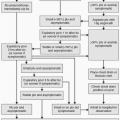Hepatic Malignancies: Radioembolization
Robert J. Lewandowski
Riad Salem
Radioembolization, a form of intra-arterial brachytherapy, is a technique where particles of glass or resin, impregnated with the isotope yttrium-90 (90Y), are infused through a catheter directly into the hepatic arteries. 90Y is a pure beta emitter and decays to stable zirconium-90 with a physical half-life of 64.1 hours. The average energy of the beta particles is 0.9367 MeV, has a mean tissue penetration of 2.5 mm, and a maximum penetration of 10 mm. Once the particles are infused through the catheter into the hepatic artery, they travel to the distal arterioles within the tumors, where the beta emissions from the isotope irradiate the tumor.
Indications
1. Glass microspheres
a. TheraSphere was approved by the U.S. Food and Drug Administration (FDA) in 1999 under a humanitarian device exemption, defined as safe and probably beneficial for the treatment of unresectable hepatocellular carcinoma (HCC) with or without portal vein thrombosis (PVT), or as a bridge to transplantation in patients who could have appropriately positioned catheters. This device is also approved for the treatment of liver neoplasia in Europe and Canada.
2. Resin microspheres
a. SIR-Spheres were granted premarket approval by the FDA in 2002, defined as safe and effective for the treatment of metastatic colorectal cancer to the liver with concomitant use of floxuridine. This device is also approved in Europe, Australia, and various Asian countries for the treatment of liver neoplasia.
Contraindications
Absolute
1. Contraindications to angiography
a. Uncorrectable coagulopathy
b. Severe renal insufficiency
c. Severe anaphylactoid reaction to iodinated contrast agents
d. Severe peripheral vascular disease precluding arterial access
2. Immediate life-threatening extrahepatic disease
3. Inability to prevent 90Y delivery to the gastrointestinal (GI) tract
4. Hepatopulmonary lung shunting
a. For TheraSphere, the limitation of what can be administered to the lungs is based on the lung dose, not lung shunt fraction (LSF) (30 Gy per infusion, 50 Gy cumulative).
b. For SIR-Spheres, infusion is limited by the LSF (20%).
Relative
1. PVT
a. Patients with main PVT have poor prognosis; Child-Pugh A patients with main PVT may be safely treated.
b. Radioembolization is not contraindicated in lobar or segmental PVT.
2. Poor hepatic reserve
a. Total bilirubin >2 mg per dL
b. Risks may be mitigated by selective radioembolization.
3. Poor performance status
a. Eastern Cooperative Oncology Group (ECOG) >2
4. Biliary obstruction
a. Risks of infectious complications significantly higher in the setting of compromised sphincter of Oddi
Preprocedure Preparation
1. Patient selection
a. History, physical examination, and assessment of performance status
b. Clinical laboratory tests (complete blood count with differential, blood urea nitrogen, serum creatinine, serum electrolytes, liver function, albumin, lactate dehydrogenase [LDH], prothrombin time [PT], tumor marker assay: carcinoembryonic antigen [CEA], α-fetoprotein [AFP])
c. Chest computed tomography (CT) for assessment of lung metastases
d. CT/magnetic resonance imaging (MRI) scan of the abdomen and pelvis for staging with assessment of portal vein patency
e. Arteriography/macroaggregated albumin lung shunting study
2. Patient preparation
a. Patients are nil per os (NPO) 6 hours prior to procedure.
(1) Medications are allowed with sips of water.
b. Peripheral intravenous line placed prior to procedure
(1) Hydration of patients with renal insufficiency
Procedure
1. Pretreatment angiography (1): To define hepatic arterial anatomy, allow embolization of communicating vessels that may lead to aberrant microsphere deposition, and facilitate radiation dosimetry.
a. Abdominal aorta (pigtail catheter; 15 mL per second for 30 mL)
(1) Allows for the evaluation of celiac axis, superior mesenteric artery (SMA) and renal artery patency, aortic tortuosity, as well as guiding proper visceral catheter selection
b. SMA (reverse curve catheter; 3 mL per second for 30 mL)
(1) Allows for the identification of a replaced right hepatic, replaced proper hepatic, replaced common hepatic, accessory right hepatic, and patency of the portal vein as well as the rare parasitization of blood flow from the SMA to the liver. Retrograde flow (from tumor sumping or celiac occlusion/stenosis) into the gastroduodenal artery (GDA) is also assessed.
c. Celiac artery (reverse curve catheter; 3 to 4 mL per second for 12 to 15 mL)
(1) Allows for the assessment of celiac anatomy and identifies the presence of any possible variants, including a replaced left hepatic artery arising off the left gastric (gastrohepatic trunk), as well as the right and left inferior phrenic arteries. The dorsal pancreatic artery may arise off the celiac.
d. Common hepatic artery (microcatheter; 3 mL per second for 10 to 12 mL)
(1) Arterial branches of note whose location should be identified that may require embolization arising off the common hepatic artery (CHA) include the right gastric, dorsal pancreatic, and gastroduodenal. Other complex variants exist:
(a) A replaced right hepatic artery off the SMA with a trifurcation from the CHA




Stay updated, free articles. Join our Telegram channel

Full access? Get Clinical Tree






